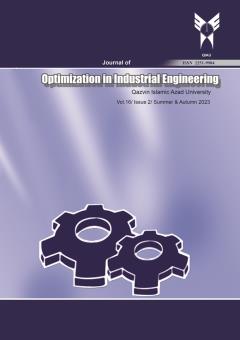Assessment of Wind Energy Potential in Green-Mountain, Libya
Subject Areas : Design of Experiment
Saad Alfalahi
1
![]() ,
Walaa Mahdi
2
,
Sabah Alwatar
3
,
Mohammed Abdulhadi
4
,
Aiman Nouh
5
,
Walaa Mahdi
2
,
Sabah Alwatar
3
,
Mohammed Abdulhadi
4
,
Aiman Nouh
5
1 -
2 -
3 -
4 -
5 -
Keywords: Wind power plants, Weibull distribution, Wind Energy, Renewable energy systems,
Abstract :
Abstract:The annual capacity additions from renewable sources across the globe are growing at a rapid rate. Considering the efforts made by the international community to mitigate the effects of global warming, it is anticipated that it will continue to rise. As a result, many nations across the globe are increasing their installed capacities by capitalizing on renewable resources, such as wind resources, in order to satisfy the rising demand for electrical power. In the first part of this study, a wind resource assessment is carried out to determine the wind potential at several different places in the Green Mountain Province, which is in the northeastern part of Libya. The sites with valuable annual wind speed frequency distribution and power density are then evaluated further to determine the technological features required for a wind farm to be constructed there. Wind turbines are chosen based on their power characteristic curves, and those curves must match the resultant wind distribution. To determine the system's financial and technical parameters, the data from the most prominent site are analyzed using two different processing technologies, both of which implement the Weibull Distribution Model. The findings indicate the possibility of implementation at least at two locations, with hub heights of 10 and 50 meters, respectively.
[1] International Energy Agency, (2021) Renewables 2021 Analysis and forecast to 2026.
[2] Elmabruk A. et al, Estimation of wind energy in Libya, the 5th international renewable energy conference. Hammamet, Tunsia, 2014.
[3] Ahwide F. et al, Estimation of Electricity Generation in Libya Using Processing Technology of Wind Available Data: The Case study in Derna. ICESD 2013, Dubai, UAE.
[4] Elansari A. et al, Impact of New Wind Farms on Power Distribution Networks (Derna Wind Project Case Study). 2012 International Conference on Renewable Energies for Developing Countries (REDEC), Beirut, Lebanon, Nov. 2012.
[5] Rajab Z. et al, Modeling Approach To Evaluate Wind Turbine Performance: Case Study For a Single Wind Turbine of 1.65 MW In Dernah, Libya. The 8th International Renewable Energy Congress (IREC 2017).
[6] Al-Hashimi S. et al, The Future of Renewable Energy in Libya. University Bulletin – ISSUE No.19- Vol. (3) – July - 2017.
[7] Mrehel O. et al, Design and Simulation of Wind Farm in Tarhuna Region with Economic Analysis. 2019 19th international conference on Sciences and Techniques of Automatic control & computer engineering (STA), Sousse, Tunisia, March 24-26, 2019.
[8] Aldricy M. et al, Practical Design and Performance Evaluation of Micro-Wind Turbine in Libya. The 9th international renewable energy congress (IREC 2018).
[9] Miu L. et al, Evaluation of Wind Energy Resources at Unmonitored Micro-Wind Application Sites from Public Weather Station Records. 6th International Conference on Clean Electrical Power (ICCEP), 2017.
[10] Belu B. , Assessment and Analysis of Offshore Wind Energy Potential. A book chapter, Web of Science. DOI: http://dx.doi.org/10.5772/intechopen.95346
[11] Samal R. K. et al., Wind Resource Assessment and Energy Analysis for Wind Energy Projects, 2017.
[12] Bloch M. et al, A Research on Electricity Generation fromWind Corridors of Pakistan (Two Provinces): A Technical Proposal for Remote Zones. Sustainability 2017, 9, 1611; doi:10.3390/su9091611
[13] Berrezzek F. et al., Estimation of wind energy potential and Weibull parameter extrapolation of the city of Annaba, Algeria. International Conference on Advanced Electrical Engineering (ICAEE), 2019.
[14] Sharma A. et al., Estimation of Weibull Parameters and Wind Power Density at Different Heights for Akal Site at Jaisalmer in Rajasthan. International Conference On Smart Technologies for Smart Nation (SmartTechCon), 2017.
[15] Waewsak J. et al, An Analysis of Wind Speed Distribution at Thasala, Nakhon Si Thammarat, Thailand. Journal of Sustainable Energy & Environment 2 (2011) 51-55.
[16] Tareka E. et al, Statistical Assessment of Potential Wind Energy Sites in Coastal and Southern Part of Namibia, International SAUPEC/RobMech/PRASA Conference, 2020.
[17] T. P. Chang, Performance comparison of six numerical methods in estimating Weibull parameters for wind energy application. Applied Energy, Vol. 88, No.1, pp. 272-282, 2011.
[18] Teyabeen A. A. et al., Power Curve Modelling for Wind Turbines. UKSim-AMSS 19th International Conference on Computer Modelling & Simulation (UKSim), 2017.
[19] Moorthy C. B. et al., Assessment of wind power potential in a region of Goa, India. IEEE Intern. Confer. on Power Electronics, Drives, and Energy Systems (PEDES), 2016.
[20] H. S. Bagiorgas, M. Giouli, S. Rehman and L. M. Al-Hadhrami, Weibull Parameters Estimation using Four Different Methods and Most Energy-Carrying Wind Speed Analysis. International Journal of Green Energy, Vol. 8, No. 5, pp. 529-554 , 2011.
[21] Freeman, J.; Jorgenson, J.; Gilman, P.; Ferguson, T., Reference Manual for the System Advisor Model's Wind Power Performance Model. Technical Report AC36-08GO28308, National Renewable Energy Lab. (NREL), United States, 2014.
[22] Elliott, D., and Schwartz, M., Wind Energy Potential in the United States. Progress report NTIS No. DE94001667, Pacific Northwest Laboratory (PNL), Richland, WA, September 1993.
[23] Gipe P., IEC Wind Turbine Classes, June 2006. Wind-Works: IEC Wind Turbine Classes.
[24] Wind was second-largest source of U.S. electricity generation on March 29, Today in Energy, April 2022, U.S. Energy Information Administration. U.S. Energy Information Administration - EIA - Independent Statistics and Analysis


